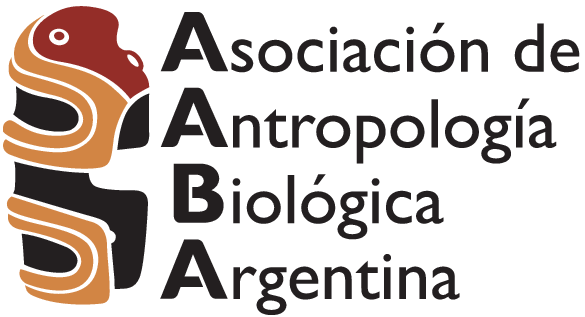Evaluación de la correlación entre atributos genéticos y apellidos: características de STRs autonómicos en individuos con apellido Mapuche y europeo
Resumen
RESUMEN Uno de los criterios de identificación vigente en los países occidentales es el determinado por el apellido. En ciertas regiones los apellidos pueden asociarse a grupos humanos definidos. Con el objeto de evaluar una posible correlación entre el origen étnico de diversas poblaciones se compararon las características genéticas de individuos cuyos apellidos incluyen elementos lingüísticos Mapuche con otros asociados a un origen europeo. En el presente trabajo se investigaron 168 individuos varones no relacionados, provenientes de las provincias patagónicas de Río Negro y Chubut, seleccionándose en cada provincia un número comparable de individuos con apellido Mapuche y europeo. Se analizaron 15 microsatélites (STRs) autosómicos, ampliamente usados en identificación humana. Los resultados obtenidos indican una diferencia significativa entre el grupo Mapuche y el europeo (Fst: 0.055; p < 0,05). Los resultados de distancias genéticas sugieren que el grupo Mapuche es genéticamente distante de las poblaciones con apellido no aborigen.
ABSTRACT One of the criteria of effective identification in western hemisphere countries is determined by the surname. In certain regions, the first family names (paternal lineage) can be associated to defined human groups. In order to evaluate a possible correlation between the ethnic origin of diverse populations with their genetic characteristics, individuals whose first family names (paternal) included Mapuche linguistic elements were compared against others associated with a European origin. The present work included the study of 168 unrelated male individuals that inhabit the Patagonian provinces of Río Negro and Chubut. The sample was classified in two groups on the basis of their paternal family name: of native or European ancestry. A total of 15 autosomal microsatellites (STRs), widely used in human identification, were analyzed. The obtained results demonstrate significant differences between the Mapuche and European groups (Fst: 0.055; p < 0,05). Genetic distances suggest that the Mapuche group is genetically distant from the populations with non-aboriginal surnames.
Descargas
Referencias
Balanovskaia EV, Pocheshkhova EA, Balanovskii OP y Ginter EK (2000) Genogeographic analysis of a subdivided population: Geography of random inbreeding from frequency of surnames in Adygs. Genetika 36(8): 1126-1139. Barrai I, Rodriguez-Larralde A, Manni F y Scapoli C (2002) Isonymy and isolation by distance in the Netherlands. Hum. Biol. 74(2):263-283.
Bianchi NO, Catanesi Cl, Bailliet G, Martínez-Marignac VL, Bravi CM, Vidal-Rioja LB, Herrera RJ y López-Camelo JS (1998) Characterization of ancestral and derived Y-chromosome haplotypes of New World native populations. Am. J. Hum. Genet. 63(6): 1862-1871.
Bonferroni CE (1936) Teoria statistica delle classi e calcolo delle probabilità. Pubblicazioni del R. Istituto Superiore di Scienze Economiche e Commerciali di Firenze 8:3-62.
Bortolini MC, Salzano FM, Bau CH, Layrisse Z, Petzl-Erler ML, Tsuneto LT, Hill K, Hurtado AM, Castro-De-Guerra D, Bedoya G y Ruiz-Linares A (2002) Y-chromosome biallelic polymorphisms and Native American population structure. Ann. Hum. Genet. 66:255-259.
Bravi CM, Bailliet G, Martinez-Marignac VL y Bianchi NO (2000) Origin of YAP+ lineages of the human Y-chromosome. Am. J. Phys. Anthropol. 112(2): 149-158.
Callegari-Jacques SM y Salzano FM (1999) Brazilian Indian/non-Indian interactions and their effects. Ciência e Cultura 51:166-174.
Chakraborty R, Barton SA, Ferrell RE y Schull WJ ( 1989) Ethnicity determination by names among the Aymara of Chile and Bolivia. Hum. Biol. 61 (2): 159-177.
Christensen AF (1999) Population relationship by isonymy in frontier Pennsylvania. Hum. Biol. 71(5):859-873.
Cockerham CC (1971) Higher order probabilities of identity of alleles by descent. Genetics 69:235-246.
Colantonio SE, Fuster V y Marcellino AJ (2002) Inter-population relationship by isonymy: Application to ethno-social groups and illegitimacy. Hum. Biol. 74:871-878.
Colantonio SE, Lasker GW, Kaplan BA y Fuster V (2003) Use of surname models in human population biology: A review of recent developments. Hum. Biol. 75:785-807.
Corach D, Marino M y Sala A (2004) Evaluation of the ethnic composition in the population of Argentina. IV International Forensic Y-User Workshop. Berlin.
Corach D, Marino M y Sala A (2006) Relevant genetic contribution of Amerindian to the extant population of Argentina. Progress in Forensic Genetics 11 (en prensa).
Crawford MH (1998) The Origins of Native Americans. Evidence from Anthropological Genetics. Cambridge, Cambridge University Press.
Deka R, Shriver MD, Yu LM, Heidrich EM, Jin L, Zhong Y, McGarvey ST, Agarwal SS, Bunker CH, Miki T, Hundrieser J, Yin SJ, Raskin S, Barrantes R, Ferrell RE y Chakraborty R (1999) Genetic variation at twenty three microsatellite loci in sixteen human populations. J. Genet. 78:99-121.
ExcofTier L, Laval G y Schneider S (2005) Arlequin ver. 3.0: An integrated software package for population genetics data analysis. Evolutionary Bioinformatics Online.
Ginther C, Corach D, Penacino GA, Rey JA, Camese FR, Hutz MH, Anderson A, Just J, Salzano FM y King MC (1993) Genetic variation among the Mapuche Indians from the Patagonian region of Argentina: mitochondrial DNA sequence variation and allele frequencies of several nuclear genes. EXS 67:211 A. SALA ETAL.
Goicoechea AS, Camese FR, Caratini AL, Avena S, Salaberry M y Salzano FM (2000) Demography, genetic diversity, and population relationships among Argentinean Mapuche Indians. Genetics and Molecular Biology 23(3):513-518.
Goicoechea AS, Camese FR, Dejean C, Avena SA, Weimer TA, Estalote AC, Simoes MLMS, Palatnik M, Salamoni SP, Salzano FM y Callegari-Jacques SM (2001) New genetic data on Amerindians from the Paraguayan Chaco. Am. J. Hum. Biol. 13:660-667.
Guo S y Thompson E (1992) Performing the exact test for Hardy-Weinberg proportion for multiple alleles. Biometrics 48:361-372.
Jobling MA (2001 ) In the name of the father: surnames and genetics. Trends Genet. 17(6):353-357.
Kaufman L, Camese FR, Goicochea A, Dejean A, Salzano F y Hutz M (1998) Beta-globin gene cluster haplotypes in the Mapuche Indians of Argentina. Genet. Mol. Biol. 21:435-437.
Little B y Malina R (2005) Inbreeding avoidance in an isolated indigenous Zapotec community in the Valley of Oaxaca, Southern Mexico. Hum. Biol. 77:306-316.
Manni F, Toupance B, Sabbagh A y Heyer E (2005) New method for surname studies of ancient patrilineal population structures, and possible application to improvement ofY-chromosome sampling. Am. J. Phys. Anthropol. 126(2):214-228.
Martinez-Labarga C, Rickards O, Scacchi R, Corbo RM, Biondi G, Pena JA, Va-ras de Viera C, Guevara AE, Santurino MS y de Stefano GF (1999) Genetic population structure of two African-Ecuadorian communities of Esmeraldas. Am. J. Phys. Anthropol. 109(2): 159-174.
Martinez Marignac VL, Bertoni B, Parra EJ y Bianchi NO (2004) Characterization of admixture in an urban sample from Buenos Aires, Argentina, using uniparentally and biparentally inherited genetic markers. Hum. Biol. 76(4):543-557.
Martinez Sarasola C (1995) Nuestros Paisanos los Indios. Buenos Aires, Editorial Emecé S.A.
Nei M (1987) Molecular Evolutionary Genetics. New York, Columbia University Press.
Pettener D, Pastor S y Tarazona-Santos E (1998) Surnames and genetic structure of a high-altitude Quechua community from the Ichu River valley, Peruvian Central Andes, 1825-1914. Hum. Biol. 70(5):865-887.
Raymond M y Rousset F (1995) An exact test for population differentiation. Evolution 49:1280-1283.
Rothhammer F, Silva C, Callegari-Jacques SM, LIop E y Salzano FM (1997) Gradients of HLAdiversity in South American Indians. Ann. Hum. Biol. 24:197-208.
Sala A, Penacino G y Corach D (1998) Comparison of allele frequencies of eight STR loci from Argentinan Amerindian and European Populations. Hum. Biol. 70(5):937-947.
Sala A, Penacino G, Carnese R y Corach D (1999) Reference database of hypervariable genetic markers of Argentina: applications for molecular anthropology and forensic casework. Electrophoresis 208:1733-1739.
Santos C, Abade A, Cantons J, Mayer F, Aluja M y Lima M (2005) Genetic structure of Flores Island (Azores, Portugal) in the 19th century and in the present day: evidence from surname analysis. Hum. Biol. 77(3):317-324.
Slatkin M (1995) A measure of population subdivision based on microsatellite allele frequencies. Genetics 139:457-462.
Sykes B e Irven C (2000) Surnames and the Y Chromosome. Am. J. Hum. Genet. 66:1417-1419.
Descargas
Publicado
Número
Sección
Licencia
La RAAB es una revista de acceso abierto tipo diamante. No se aplican cargos para la lectura, el envío de los trabajos ni tampoco para su procesamiento. Asímismo, los autores mantienen el copyright sobre sus trabajos así como también los derechos de publicación sin restricciones.






























